Description of Test
This was a test of Scientific Enquiry skills, based on the UK National Curriculum that was current at the time of the study. The test included 39 items. In the raw data on the web server, the items were numbered from 0 to 38 (labelled T100 to T138); for easier reference to original source materials (see measures), the items were also given question numbers from 1 to 24, with letters A/B/C/D to distinguish between parts of some questions. The questions are presented in full, with both numbering systems, in the table of test items at the bottom of this page. The test rules are described in full below.
In the original source materials, some questions had multiple parts. For this web test, these part-questions have been separated into independent test items; where necessary, the introduction to the question (text and/or image) has been duplicated for the part-questions. In this web test, such part-questions have the same question number but are distinguished by letters A/B/C/D (see for example questions 2A and 2B).
The question/response format varies widely between the items of this test. The majority of the questions are multiple-choice, in which the twin simply clicks on the chosen response. In some other questions, the twin must select more than one response and then click on "OK". In two of the questions, numeric answers are required so the twin must type a number in a box and then click on "OK". In one question, four text responses are required: the twin must type answers into four boxes and then click on "OK". See the table of test items for full details.
Test Rules
- Scoring
For 36 of the 39 items, there is only 1 mark available: the correct response is given a score of 1, while all other responses are given a score of 0 (although question 3 has two alternative correct responses, each gaining a score of 1).
However, three items (6, 10A and 17B) each have up to 4 marks available depending on the set of responses given; a completely correct set of responses is given a score of 4, partly-correct responses are given scores of 1, 2 or 3, while a completely incorrect set of responses is given a score of 0.
The maximum total score for the test is 48. - Ordering of items
Items are presented in ascending order of item number, subject to the discontinue rule below. There are no branching rules. - Discontinue rule
Discontinue the test after 5 consecutive incorrect items, each with zero score. For this rule, part-questions (like 2A, 2B) that are displayed separately on screen count as separate items. An item with 4 marks available (such as 10A) still only counts as one item for this rule. Likewise, any item requiring several responses (such as 20) still only counts as one item. - Timeout rule
There is no special timeout rule for this test, so the default timeout of 5 minutes applies to each item. See the summary of 14 Year web tests for more details. - Item validation
Some test items incorporate validation rules, in order to prevent invalid responses. The items fall into several broad categories, which are validated as follows:- Items 2B and 9D: the twin is required to type in a number; non-numeric entries are rejected; missing responses are rejected.
- Item 6: the twin is required to type "iron", "sand", "salt" and "cork" into four boxes; all other text strings are rejected; missing responses in any of the boxes are rejected; attempts to type the same word in more than one box are rejected.
- Items 10A, 15, 17B, 18B, 19, 20 and 24: the twin is required to select 2, 3 or 4 responses before clicking "OK"; attempts to select too few or too many responses are rejected; for item 19, attempts to select the same response twice are rejected.
- All other items: the twin is simply required to click on one response (no validation required).
Item Variables
The item variables relating to the Science test, as listed in the table below, were generated automatically by programs on the web server during the course of the test. This includes the variable holding the total test score, which is therefore treated as an item variable not a derived variable. Note that the dataset only includes data for completed tests. If a twin started the test but left it unfinished, then the data for the test were not used. Note that the variable holding the total test score was also generated automatically on the web server. It is therefore treated as an item variable (it did not have to be derived as at age 10).
In most cases the values of these variables have been left unaltered, although some have been recoded during data cleaning as follows. See the web data cleaning page for further details.
- Response (answer) variables that were encoded as strings have, wherever possible, been recoded into numeric variables. Most questions have a multiple-response format, where the response has been coded into simple numeric categories. Two questions had numeric inputs, which have been converted from strings to the numeric values. In a few other cases, a question that required two or more responses, sometimes ordered, and in these cases the original string response has been retained. See the table of items below for details of value coding.
- For timed out items, the item response variable is recoded from the default value (usually missing) to -1, and the item answer time is recoded to missing (item scores are 0)
- For items skipped due to the discontinue rule, the item response variable is recoded to -2, and the item score is recoded from missing to 0.
- For items that were interrupted, crashed or malfunctioned in any way, the item response variable is recoded to -4, and the item score is recoded to 0.
- For instances of tests compromised by excessive loss of data, the status flag is recoded from 2 to 3, the data flag is recoded from 1 to 0, and all item variables are recoded to missing (test data deleted)
- For twins identified as random responders in this test, the status flag is recoded from 2 to 4, the data flag is recoded from 1 to 0, and all item variables are recoded to missing (test data deleted)
The test start and end dates and times, and item answer and download times, have not been retained in the dataset.
| Variables | Explanation | Values |
|---|---|---|
| nscdata1/2 | Data flag: was this test completed? | 0=no, 1=yes |
| nscstat1/2 | Test status: outcome of test | 0=not started, 1=started but not finished, 2=successfully completed, 3=test compromised by loss of data, 4=random responses |
| nsctot1/2 | Total score for this test, out of 48. | 0 to 48 (integer values) |
| nscstdt1/2 | Start date of the test [not in dataset] | Date values |
| nscsttm1/2 | Start time of the test [not in dataset] | Time values |
| nscendt1/2 | End date of the test [not in dataset] | Date values |
| nscentm1/2 | End time of the test [not in dataset] | Time values |
| nscsess1/2 | Number of sessions (at the computer) used by the twin to complete the test. | Integer values of 1 or above |
| nsctime1/2 | Time taken to complete the test, in seconds | Integer values (number of seconds) |
| nscXXZan1/2 where XX is the question number (01-28) and, where appropriate, Z is the question part (A,B,C,D) |
Item response (see table of items below for details) | (different items have responses encoded in different ways) |
| nscXXZsc1/2 where XX is the question number (01-28) and, where appropriate, Z is the question part (A,B,C,D) |
Item score (see table of items below for details) | Items 6, 10A and 17B: 0 to 4 (integer values). All other items: 0=incorrect, 1=correct. |
| nscXXZat1/2 where XX is the question number (01-28) and, where appropriate, Z is the question part (A,B,C,D) |
Answer time: length of time (in seconds) taken by the twin to respond to this item [not in dataset] | Integer values (number of seconds) |
| nscXXZdt1/2 where XX is the question number (01-28) and, where appropriate, Z is the question part (A,B,C,D) |
Download time: length of time (in seconds) between the end of the previous item and the start of this item; time needed to download files for this item [not in dataset] | Integer values (number of seconds) |
Test Items
Items were presented to twins in order of item number (first column, 0 to 38), subject to the discontinue rule (see test rules above).
The question numbers (second column, 1 to 24 with parts A/B/C/D in some cases) are incorporated into the item variable names (see item variables above).
The response coding (last column) relates to the value coding used in the item response variables (see item variables above).
| item number | question number | question | correct response | response coding |
|---|---|---|---|---|
| 0 | 1 | The graph shows temperature changes in a healthy
person’s body. At which time (A, B, C or D) would the person shiver? Click on it. 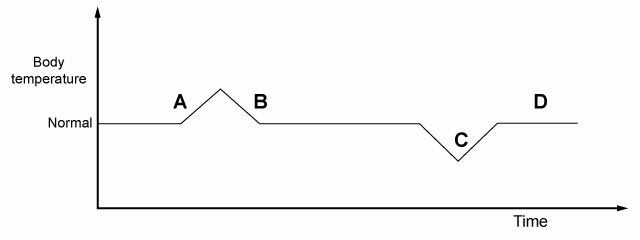 | C | 1=A, 2=B, 3=C, 4=D |
| 1 | 2A | Four runners compete in a 100m race. The graph shows how the distance travelled by each runner changes with time. Who won the race? Click on the winner's name. 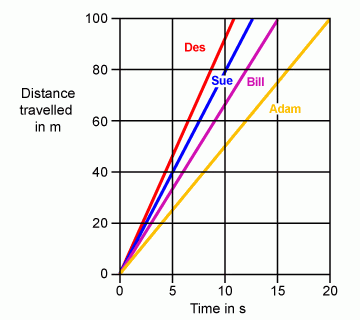 | Des | 1=Des, 2=Sue, 3=Bill, 4=Adam |
| 2 | 2B | Four runners compete in a 100m race. The graph shows how the distance travelled by each runner changes with time. How long did it take Adam to run 100m? Type in the answer.  | 20 | number as typed by the twin |
| 3 | 3 | Gary works for the Water Authority. His job is to
sample water to find out how clean it is. Look at the table. It shows some
of the animals he looks for in the water. It also shows the type of water
they can live in. Click on ONE animal that cannot tolerate pollution. 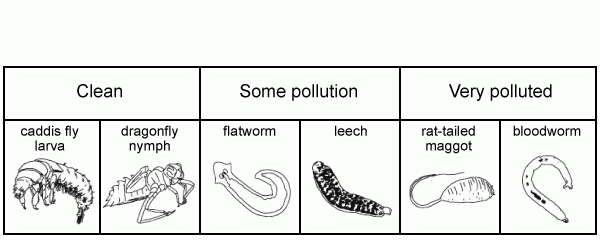 | EITHER caddis fly larva OR dragonfly nymph | response options numbered 1-6 (left-to-right) |
| 4 | 4 | A candle is placed on a ruled grid in front of a
mirror, as shown. At what point (A, B, C or D) will the reflection of the candle appear to be? Click on it. 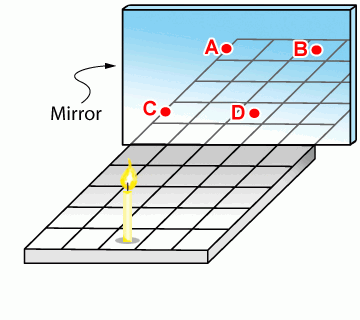 | B | 1=A, 2=B, 3=C, 4=D |
| 5 | 5A | Some students used a detector to compare the air in
the city centre with air in the school playground. The detector measures how
much carbon monoxide there is in a sample of air. Each student took one
measurement in each place. Here are the results from the five students. One student did not use the meter properly in the city centre. Which student was this? Click on this student. 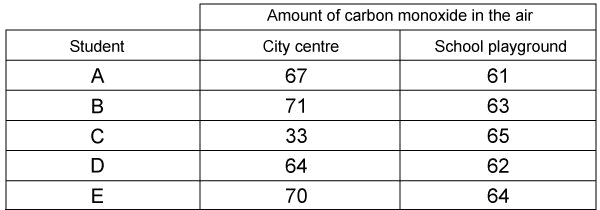 | C | 1=A, 2=B, 3=C, 4=D, 5=E |
| 6 | 5B | Some students used a detector to compare the air in
the city centre with air in the school playground. The detector measures how
much carbon monoxide there is in a sample of air. Each student took one
measurement in each place. Here are the results from the five students. What should be done with this mistake when calculating the best estimate of how much carbon monoxide there is in a sample of air? Click on the correct answer. 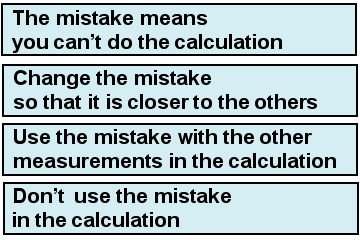 | 4th option | response options numbered 1-4 (top-to-bottom) |
| 7 | 6 | Robert is given a mixture of salt, sand, iron
filings, and small pieces of cork. He separates the mixture using a 4-step
procedure as shown in the diagram. Identify what each component is by writing salt, sand, iron or cork in the boxes opposite. 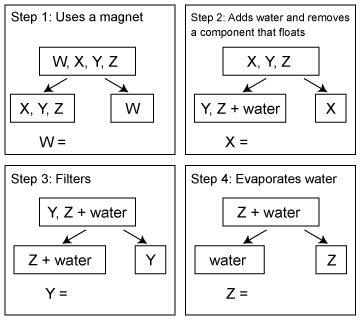 |
4 marks available, 1 for each correct response. Correct responses are: W=iron, X=cork, Y=sand, Z=salt | string containing the four text responses as typed by the twin (in order W, X, Y, Z) |
| 8 | 7 | Filtration using the equipment shown can be used to
separate which materials?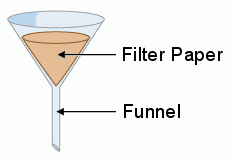 Click on the correct answer. 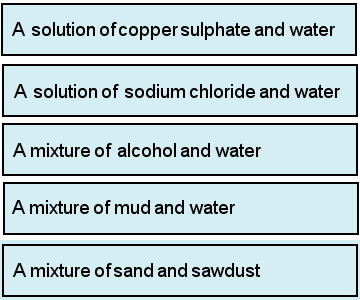 | 4th option | response options numbered 1-5 (top-to-bottom) |
| 9 | 8 | Whenever scientists carefully measure any quantity
many times, they expect what? Click on the correct answer. 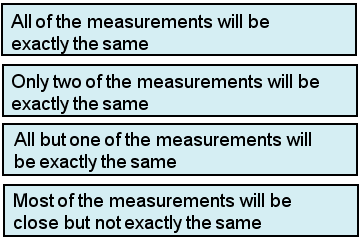 | 4th option | response options numbered 1-4 (top-to-bottom) |
| 10 | 9A | Two groups of pupils investigated the factors
affecting the time taken for an indigestion tablet to dissolve in 100cm³ of
water.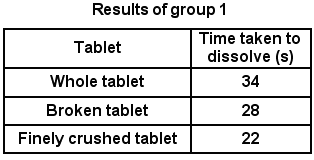 What factor did group 1 change as they carried out their investigation? Click on the correct answer. 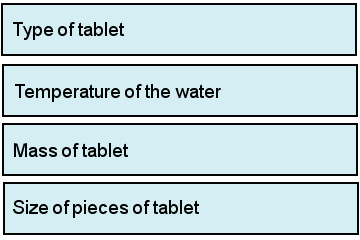 | 4th option | response options numbered 1-4 (top-to-bottom) |
| 11 | 9B | Two groups of pupils investigated the factors
affecting the time taken for an indigestion tablet to dissolve in 100cm³ of
water. Before the investigation group 1 made a prediction. They found this prediction was supported by the results in the table. What prediction did group 1 make? Click on the correct answer. 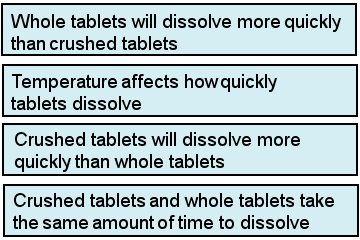 | 3rd option | response options numbered 1-4 (top-to-bottom) |
| 12 | 9C | Two groups of pupils investigated the factors
affecting the time taken for an indigestion tablet to dissolve in 100cm³ of
water.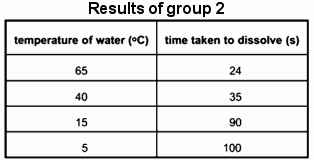 Group 2 investigated how the temperature of the water affects the time taken for a whole tablet to dissolve. What do the results recorded by group 2 show? Click on the correct answer. 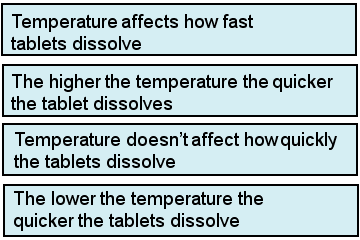 | 2nd option | response options numbered 1-4 (top-to-bottom) |
| 13 | 9D | Two groups of pupils investigated the factors
affecting the time taken for an indigestion tablet to dissolve in 100cm³ of
water. Look at the results presented by group 1 and group 2. Both groups used the same type of tablet. Estimate the temperature of the water used by group 1. Type in the answer.  | any number in the range 38 to 44 | number as typed by the twin |
| 14 | 10A | Two pupils investigated the effect of temperature
on how fast oil flows through a funnel. Complete the table below to show
what they should do with each factor in their investigation. Click on ONE action dot for EACH factor. 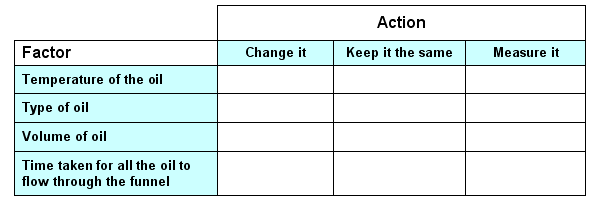 |
4 marks available, 1 for each correct response. Correct responses are (top-to-bottom): change it; keep it the same; keep it the same; measure it. |
String containing the four responses in order (top-to-bottom). Within the string, each response is coded as 1=change it, 2=keep it the same, 3=measure it. |
| 15 | 10B | Two pupils investigated the effect of temperature
on how fast oil flows through a funnel. Look at their results in the table
below. 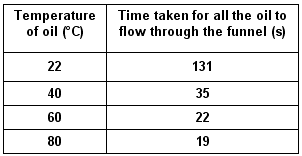 What happens to the time taken for the oil to flow through the funnel as its temperature increases? Click on the correct answer. 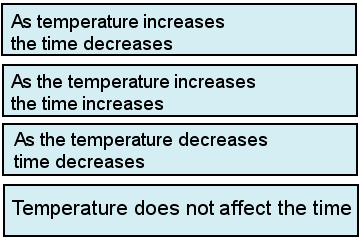 | 1st option | response options numbered 1-4 (top-to-bottom) |
| 16 | 10C | Two pupils investigated the effect of temperature
on how fast oil flows through a funnel. Look at their results in the table
below.  How long would it take for all the oil to flow through the funnel at 15°C? Click on the correct answer. 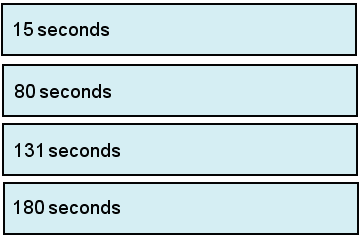 | 4th option | response options numbered 1-4 (top-to-bottom) |
| 17 | 11A | Lee investigated the effects of fizzy cola drink
on his heart rate. First he measured his heart rate every minute for 5
minutes when sitting down. Then he drank some cola. He continued to measure
his heart rate at regular intervals. Why did Lee measure his heart rate every minute for 5 minutes before drinking his cola? Click on the correct answer. 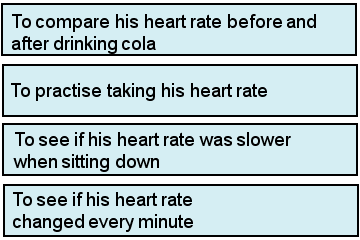 | 1st option | response options numbered 1-4 (top-to-bottom) |
| 18 | 11B | Lee investigated the effects of fizzy cola drink
on his heart rate. First he measured his heart rate every minute for 5
minutes when sitting down. Then he drank some cola. He continued to measure
his heart rate at regular intervals. Lee says cola affects his heart rate.
This is a graph of his results:  What evidence is there in the graph to support his idea that cola affects his heart rate? Click on the correct answer. 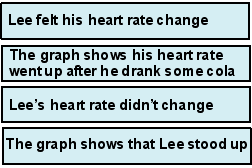 | 2nd option | response options numbered 1-4 (top-to-bottom) |
| 19 | 11C | Lee investigated the effects of fizzy cola drink
on his heart rate. First he measured his heart rate every minute for 5
minutes when sitting down. Then he drank some cola. He continued to measure
his heart rate at regular intervals. Lee and Emma came to the following
conclusions.  Why is Emma’s conclusion better than Lee’s conclusion? Click on the correct answer. 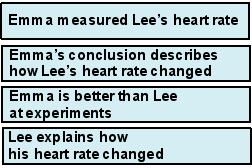 | 2nd option | response options numbered 1-4 (top-to-bottom) |
| 20 | 11D | Lee investigated the effects of fizzy cola drink
on his heart rate. First he measured his heart rate every minute for 5
minutes when sitting down. Then he drank some cola. He continued to measure
his heart rate at regular intervals. Emma said, “We should also measure
Lee’s heart rate after he drinks fizzy water”. How would measuring Lee’s heart rate after he drinks fizzy water improve the investigation? Click on the correct answer. 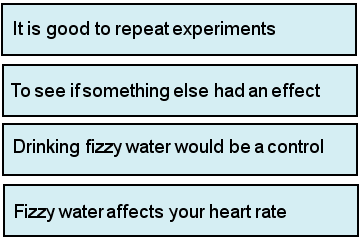 | 3rd option | response options numbered 1-4 (top-to-bottom) |
| 21 | 12 | Maria collected the gas given off by a glowing
piece of charcoal. The gas was then bubbled through a small amount of
colourless limewater. Part of Maria’s report stated, “After the gas was put
into the jar, the limewater gradually changed to a milky colour.” This statement is: … Click on the correct answer. 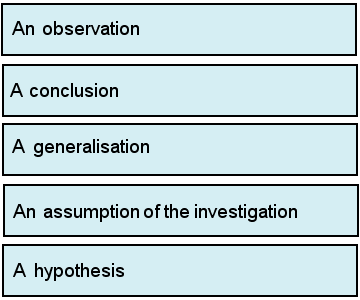 | 1st option | response options numbered 1-5 (top-to-bottom) |
| 22 | 13 | Chris and Sarah have four materials to make a
temporary shelter from the rain. They investigate which would be best to use
to keep them dry. They poured the same amount of water onto each material. What should they look for to find out whether each material is waterproof? Click on the correct answer. 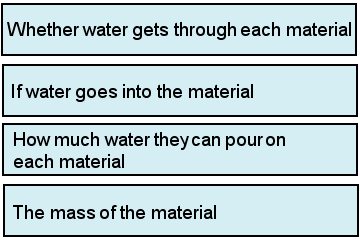 | 1st option | response options numbered 1-4 (top-to-bottom) |
| 23 | 14A | The table shows the volume of blood flowing
through different parts of the body at rest and during exercise. Which part of the body has the greatest blood flow at rest? Click on it. 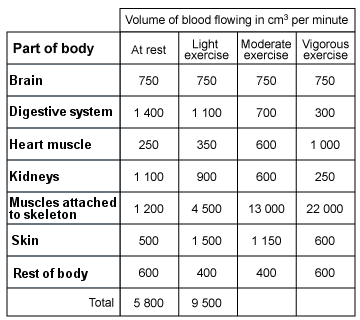 | 2nd option (digestive system) | response options numbered 1-7 (top-to-bottom) |
| 24 | 14B | The table shows the volume of blood flowing
through different parts of the body at rest and during exercise. In which part of the body does the blood flow decrease by 50% between rest and moderate exercise? Click on it.  | 2nd option (digestive system) | response options numbered 1-7 (top-to-bottom) |
| 25 | 14C | The table shows the volume of blood flowing
through different parts of the body at rest and during exercise. The graphs
show how the blood flow through different organs changes as the exercise
increases. Which graph shows the change in blood flow through the skin as exercise increases? Click on it.  | 2nd option | response options numbered 1-4 (left-to-right) |
| 26 | 15 | The diagrams show different trials Charly carried
out with carts having different-sized wheels. He started them from different
heights and the blocks he put in them were of equal mass. He wants to test
this idea: The heavier a cart is, the greater its speed at the bottom of the
ramp. Which 3 trials should he compare? Click on the 3 trials he should compare. 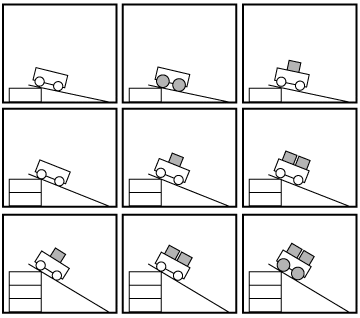 |
The three trials shown in the middle row (4, 5 and 6). Need all three correct for score of 1. | string containing the three selected response options; the response options are numbered 1-9 (left-to-right then top-to-bottom) |
| 27 | 16 | Trisha did several experiments to germinate corn.
She summed up her results as follows: 1. Moist grains of corn germinate in the light. 2. Moist grains of corn germinate in the dark. What can you conclude from her results? Click on the correct answer. 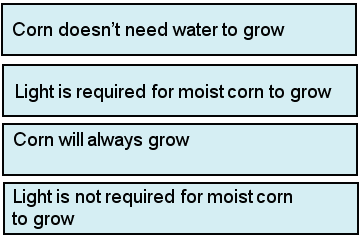 | 4th option | response options numbered 1-4 (top-to-bottom) |
| 28 | 17A | Two pupils planted lettuce seeds at three
different temperatures. They planted the same number of seeds at each
temperature. The pupils were trying to find out something about seeds. What question were the pupils investigating? Click on it. 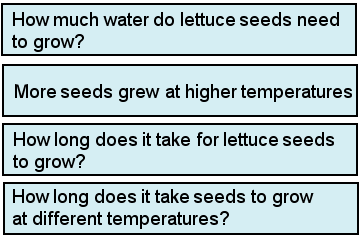 | 4th option | response options numbered 1-4 (top-to-bottom) |
| 29 | 17B | Two pupils planted lettuce seeds at three
different temperatures. They planted the same number of seeds at each
temperature. The pupils discussed their results and made the conclusions listed below. Look at their results in the table and decide whether each conclusion below is TRUE, FALSE or you CANNOT TELL. Click on one answer dot for each conclusion.  |
4 marks available, 1 for each correct response.
Correct responses are (top-to-bottom): true; cannot tell; false; false. | String containing the four responses in order
(top-to-bottom). Within the string, each response is coded as 1=true, 2=false, 3=cannot tell. |
| 30 | 18A | The children investigate the pitch of notes made
by guitar strings of different thicknesses. They want to make their test
fair. What is the ONE and ONLY thing they should plan to change as they do their investigation? Click on the correct answer. 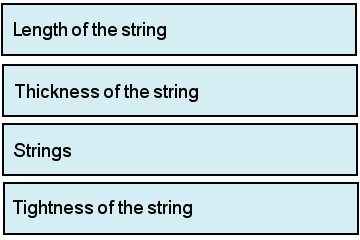 | 2nd option | response options numbered 1-4 (top-to-bottom) |
| 31 | 18B | The children investigate the pitch of notes made
by guitar strings of different thicknesses. They want to make their test
fair. Click on TWO things they should keep the same to make their test fair. 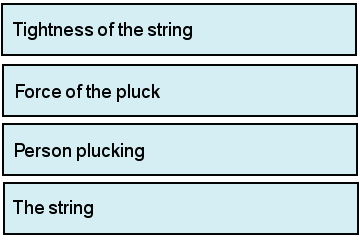 | 1st AND 2nd options (both required for a score of 1) | String
containing the two selected response options. Within the string, the response options are coded 1-4 (top-to-bottom). |
| 32 | 18C | The children investigate the pitch of notes made
by guitar strings of different thicknesses. They want to make their test
fair. What must they compare to find the result of their investigation? Click on ONE thing from the list opposite: 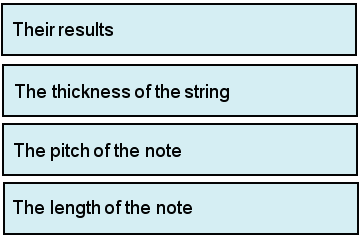 | 3rd option | response options numbered 1-4 (top-to-bottom) |
| 33 | 19 | For each question in the list below, choose the
best way of finding the answer. Click on one answer dot for each question. Use each answer ONCE only. 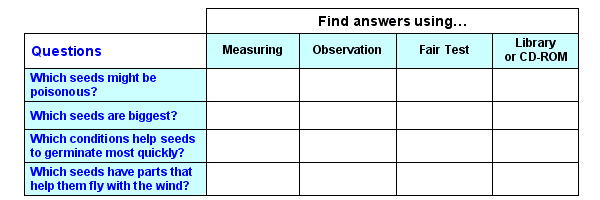 |
Only 1 mark available: need all four correct responses for score of 1. Correct responses are (top-to-bottom): Library or CD-ROM; Measuring; Fair Test; Observation. | String containing the four responses in order (top-to-bottom). Within the string, each response is coded as 1=Measuring, 2=Observation, 3=Fair Test, 4=Library or CD-ROM |
| 34 | 20 | The diagrams show nine different trials Harriet
carried out using carts with wheels of two different sizes and different
numbers of blocks of equal mass. She used the same ramp for all trials,
starting the carts from different heights. She wants to test this idea: The
higher the ramp is placed, the faster the cart will travel at the bottom of
the ramp. Which 3 trials should she compare? Click on the 3 trials she should compare. 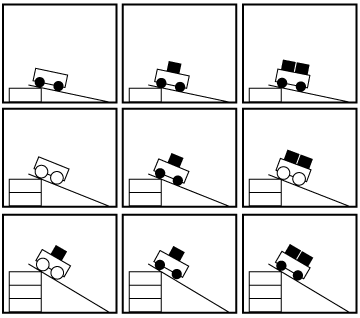 |
The three response options in the middle column (options 2, 5 and 8). Need all three correct for score of 1. | string containing the three selected response options; the response options are numbered 1-9 (left-to-right then top-to-bottom) |
| 35 | 21 | The primary reason scientists repeat the
measurements they take during experiments is so that they can:… Click on the correct answer. 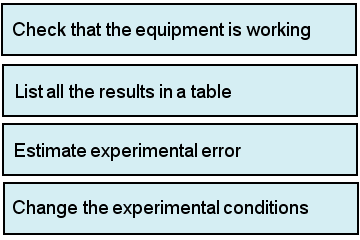 | 3rd option | response options numbered 1-4 (top-to-bottom) |
| 36 | 22 | Alexander Fleming noticed that bacteria growing on
a plate of agar did not grow next to a mould that was growing on the same
plate. He wrote in his laboratory report: “The mould may be producing a
substance that kills bacteria.” This statement is best described as:… Click on the correct answer. 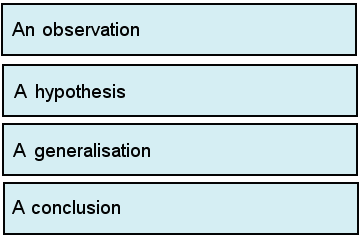 | 2nd option | response options numbered 1-4 (top-to-bottom) |
| 37 | 23 | At different altitudes, the boiling point of water
ranges from about 80°C to 100°C. Which of the Celsius thermometers shown opposite would give the most accurate measurement of the boiling point of water at different altitudes? Click on it. 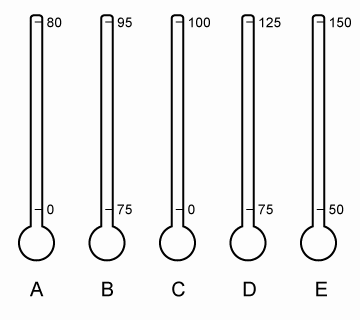 | 4th option | response options numbered 1-5 (left-to-right) |
| 38 | 24 | Houseflies carry bacteria on their feet. The flies
are attracted to faeces and human food. Each year, thousands of people in
Britain get food poisoning caused by eating food containing such bacteria. Which TWO of the following actions are most likely to give protection against infection caused by the bacteria carried by houseflies? Click on 2 answers. 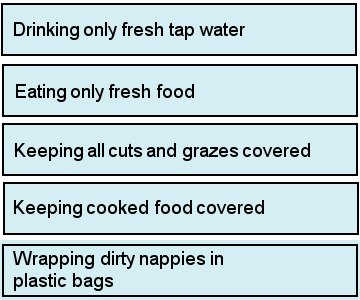 | 4th AND 5th options (both required for a score of 1) | String
containing the two selected response options. Within the string, the response options are coded 1-5 (top-to-bottom) |